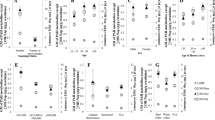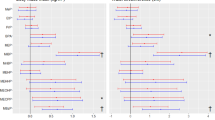Abstract
Background
Humans are widely exposed to phthalates, which are metabolized in the body and excreted in urine. Phthalate metabolites are excreted within hours of exposure, making urinary phthalate biomarker concentrations highly variable.
Objective
The goal of this study was to characterize the long-term variability in phthalate biomarker concentrations in women across the midlife transition and to identify factors that may be associated with increased variability in those phthalate biomarker concentrations by analyzing longitudinal urinary phthalate metabolite data from the Midlife Women’s Health Study (2006–2015).
Methods
A total of 741 women were enrolled in the study for a period of up to 4 years, during which they each provided 2–4 urine samples per year over 4 consecutive weeks that were pooled for analysis (1876 total pools). Nine phthalate metabolites were assessed individually and as molar sums representative of common compounds (all phthalates: ƩPhthalates; DEHP: ƩDEHP), exposure sources (plastics: ƩPlastic; personal care products: ƩPCP), and modes of action (anti-androgenic: ƩAA). Phthalate metabolites were analyzed by quartile using generalized linear models. In addition, the impact of explanatory variables (race, annual family income, and type of work) on phthalate quartile was examined using ordinal logistic regression models.
Impact statement
Phthalate biomarker concentrations are highly variable among midlife women over time, and annual sampling may not be sufficient to fully characterize long-term exposure.
This is a preview of subscription content, access via your institution
Access options
Subscribe to this journal
Receive 6 print issues and online access
$259.00 per year
only $43.17 per issue
Buy this article
- Purchase on Springer Link
- Instant access to full article PDF
Prices may be subject to local taxes which are calculated during checkout




Similar content being viewed by others
Data availability
Some or all datasets generated during and/or analyzed during the current study are not publicly available, but are available from the corresponding author on reasonable request.
References
Heudorf U, Mersch-Sundermann V, Angerer J. Phthalates: toxicology and exposure. Int J Hyg Environ Health. 2007;210:623–34.
Valvi D, Monfort N, Ventura R, Casas M, Casas L, Sunyer J, et al. Variability and predictors of urinary phthalate metabolites in Spanish pregnant women. Int J Hyg Environ Health. 2015;218:220–31.
Frederiksen H, Skakkebæk NE, Andersson AM. Metabolism of phthalates in humans. Mol Nutr Food Res. 2007;51:899–911.
Rattan S, Brehm E, Gao L, Flaws JA. Di(2-Ethylhexyl) phthalate exposure during prenatal development causes adverse transgenerational effects on female fertility in mice. Toxicol Sci. 2018;163:420–9.
Dutta S, Haggerty DK, Rappolee DA, Ruden DM. Phthalate exposure and long-term epigenomic consequences: a review. Front Genet. 2020;11:405.
Radke EG, Glenn BS, Braun JM, Cooper GS. Phthalate exposure and female reproductive and developmental outcomes: a systematic review of the human epidemiological evidence. Environ Int. 2019;130:104580.
Warner GR, Pacyga DC, Strakovsky RS, Smith R, James-Todd T, Williams PL, et al. Urinary phthalate metabolite concentrations and hot flashes in women from an urban convenience sample of midlife women. Environ Res. 2021;197:110891.
Ziv-Gal A, Gallicchio LM, Chiang C, Ther SN, Miller SR, Zacur HA, et al. Phthalate metabolite levels and menopausal hot flashes in midlife women. Reprod Toxicol. 2016;60:76–81.
Bastiaensen M, Malarvannan G, Gys C, Ait Bamai Y, Araki A, Covaci A. Between- and within-individual variability of urinary phthalate and alternative plasticizer metabolites in spot, morning void and 24-h pooled urine samples. Environ Res. 2020;191:110248.
Calafat AM, Longnecker MP, Koch HM, Swan SH, Hauser R, Goldman LR, et al. Optimal exposure biomarkers for nonpersistent chemicals in environmental epidemiology perspectives. Environ Health Perspect. 2015;123:166–8.
Aylward LL, Kirman CR, Adgate JL, McKenzie LM, Hays SM. Interpreting variability in population biomonitoring data: role of elimination kinetics. J Expo Sci Environ Epidemiol. 2012;22:398–408.
Calafat AM. Contemporary issues in exposure assessment using biomonitoring. Curr Epidemiol Rep. 2016;3:145–53.
LaKind JS, Idri F, Naiman DQ, Verner MA. Biomonitoring and nonpersistent chemicals—understanding and addressing variability and exposure misclassification. Curr Environ Health Rep. 2019;6:16–21.
Aylward LL, Hays SM, Zidek A. Variation in urinary spot sample, 24h samples, and longer-term average urinary concentrations of short-lived environmental chemicals: implications for exposure assessment and reverse dosimetry. J Expo Sci Environ Epidemiol. 2017;27:582–90.
Johns LE, Cooper GS, Galizia A, Meeker JD. Exposure assessment issues in epidemiology studies of phthalates. Environ Int. 2015;85:27–39.
Ziv-gal A, Smith RL, Gallicchio L, Miller SR, Zacur HA, Flaws JA. The Midlife Women’s Health Study – a study protocol of a longitudinal prospective study on predictors of menopausal hot flashes. Womens Midlife Health. 2017;3:4.
Högberg J, Hanberg A, Berglund M, Skerfving S, Remberger M, Calafat AM, et al. Phthalate diesters and their metabolites in human breast milk, blood or serum, and urine as biomarkers of exposure in vulnerable populations. Environ Health Perspect. 2008;116:334–9.
Wiley JF. multilevelTools: multilevel and mixed effects model diagnostics and effect sizes. 2020. https://CRAN.R-project.org/package=multilevelTools.
Bates D, Maechler M, Bolker B, Walker S. Fitting LinearMixed-Effects Models Using lme4. J Stat Software. 015;67:1–48.
The R Development Core Team. R: a language and environment for statistical computing. Vienna, Austria: R Foundation for Statistical Computing; 2017. https://www.R-project.org/.
Touloumis A. GEE solver for correlated nominal or ordinal multinomial responses. CRAN; 2014.
Dewalque L, Pirard C, Vandepaer S, Charlier C. Temporal variability of urinary concentrations of phthalate metabolites, parabens and benzophenone-3 in a Belgian adult population. Environ Res. 2015;142:414–23.
Frederiksen H, Kranich SK, Jørgensen N, Taboureau O, Petersen JH, Andersson AM. Temporal variability in urinary phthalate metabolite excretion based on spot, morning, and 24-h urine samples: considerations for epidemiological studies. Environ Sci Technol. 2013;47:958–67.
Starling AP, Engel LS, Calafat AM, Koutros S, Satagopan JM, Yang G, et al. Predictors and long-term reproducibility of urinary phthalate metabolites in middle-aged men and women living in urban Shanghai. Environ Int. 2015;84:94–106.
Casas M, Basagaña X, Sakhi AK, Haug LS, Philippat C, Granum B, et al. Variability of urinary concentrations of non-persistent chemicals in pregnant women and school-aged children. Environ Int. 2018;121:561–73.
Shin HM, Bennett DH, Barkoski J, Ye X, Calafat AM, Tancredi D, et al. Variability of urinary concentrations of phthalate metabolites during pregnancy in first morning voids and pooled samples. Environ Int. 2019;122:222–30.
Smith RL, Flaws JA, Gallicchio LM. Does quitting smoking decrease the risk of midlife hot flashes? A longitudinal analysis. Maturitas. 2015;82:123–7.
Mok S, Lim JE, Lee A, Kim S, Kim S, Lee I, et al. Within- and between-person variability of urinary phthalate metabolites and bisphenol analogues over seven days: considerations of biomonitoring study design. Environ Res. 2022;209:112885.
Acknowledgements
The authors thank the MWHS participants for their time, information, and biological samples and the staff members at Johns Hopkins University and the University of Illinois at Urbana-Champaign who helped with this study.
Funding
This work was supported by the National Institute of Environmental Health Sciences (R01 ES026956, R00 ES031150, T32 ES007326, P30 ES005022).
Author information
Authors and Affiliations
Contributions
GRW helped to write the manuscript. ZL analyzed the physical samples and reviewed the manuscript. JAF oversaw the data collection and was involved in the planning of the research. RS planned the research, conducted the data analysis, and helped to write the manuscript.
Corresponding author
Ethics declarations
Competing interests
The authors declare no competing interests.
Ethical approval
The Institutional Review Boards of the University of Illinois and Johns Hopkins University both approved this research.
Additional information
Publisher’s note Springer Nature remains neutral with regard to jurisdictional claims in published maps and institutional affiliations.
Supplementary information
Rights and permissions
Springer Nature or its licensor (e.g. a society or other partner) holds exclusive rights to this article under a publishing agreement with the author(s) or other rightsholder(s); author self-archiving of the accepted manuscript version of this article is solely governed by the terms of such publishing agreement and applicable law.
About this article
Cite this article
Warner, G.R., Li, Z., Flaws, J.A. et al. Year-to-year variation in phthalate metabolites in the Midlife Women’s Health Study. J Expo Sci Environ Epidemiol (2023). https://doi.org/10.1038/s41370-023-00614-1
Received:
Revised:
Accepted:
Published:
DOI: https://doi.org/10.1038/s41370-023-00614-1



